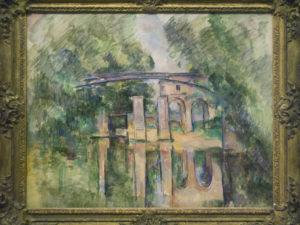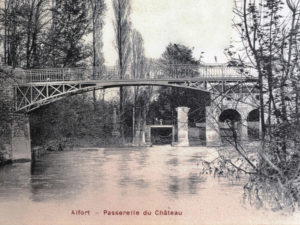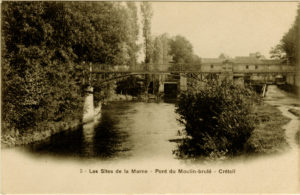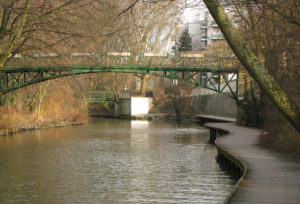R765 – Le Moulin brûlé de Charentonneau II, 1892-1894 (FWN286)
Pavel Machotka
(Cliquer sur les images pour les agrandir)
Unlike the merely serviceable bridge (Le Pont de l’île Machefer à Saint-Maur-des-Fossés), in Cézanne’s time the Moulin brûlé, a burnt-out mill and the subject of one of the recent discoveries, was a tourist attraction. Many views of it circulated on postcards, with some even picturing the Sunday strollers coming to visit it (and fishermen trying their luck in the water); the walk along the river was then, and is now, of irresistible charm. But the walk, in spite of its prominence, is not even suggested in the painting. The mill building stands isolated from contact, its only natural relationship being with the nature that surrounds it. What remains now are only the connections: not the building, but the small bridge in the distance, to the left of center, which linked the mill with the island of Charentonneau on the left, and the framing footbridge in the foreground that offered a walkway to the island. It is the double existence of the building, which seems to arise from its steely reflection in the water, that suggested a motif transcending the tourist’s Sunday view, as well as the subtle color contrast between the green vegetation and the warm colors of the mill. I rather think that the contrast was more important; in its colors the picture is subtle and luminous, situating the mill in the context of its complementary hue. The green part is merely dashed off, admittedly, but the specific colors chosen for the stone are delicate, carefully modulated, even astutely chosen: they are sand, pink, light violet, and pale blue. They shimmer not like the surface of water but like taffeta silk. If Cézanne felt at this point in his painting that he had said all he had to say, one would be tempted to agree with him; the sketchy greens there merely play a supporting role.
Source: Machotka, Cézanne: Landscape into Art
Noter que Cezanne a représenté le Moulin Brûlé de Charentonneau vu de plus loin sur une autre toile, commentée ainsi par le Musée d’Israel :
« By the time Country House by the Water was painted, Paul Cézanne had mastered his impetuous nature and had slowly evolved his own unique style. He had learned much about color and plein-air painting, particularly with Pissarro’s gentle prodding, but he rejected the Impressionists’ emphasis on capturing the fleeting moment. Instead, Cézanne had arrived at a mode of expression which, while based on nature, introduced organized forms and a new way of presenting depth and volume.
In this work, the centrally placed house is composed of simplified geometric forms. Even its reflections and the surrounding water have an aspect of solidity and stability. Depth and volume are achieved by the manipulation of color alone, and result from the juxtaposition of darker and lighter shades and tones. Structured color planes composed of directional brushstrokes, particularly in the trees, further contribute to the overall architectural order of the composition ».
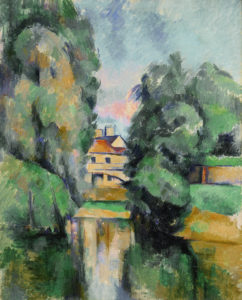
Le Moulin brûlé de Charentonneau I, 1892-1894
R727 FWN285

